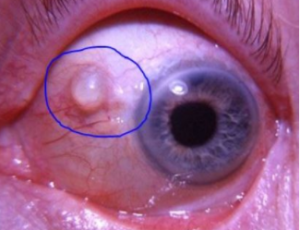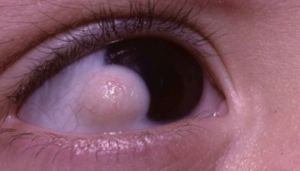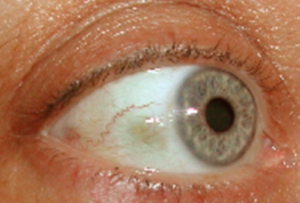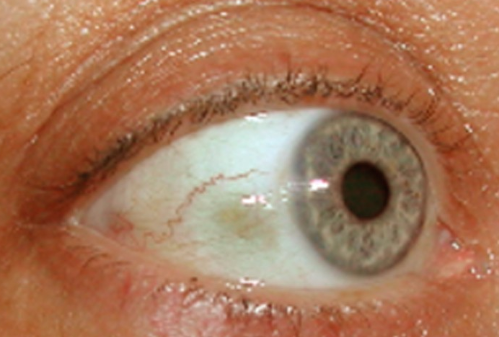A bump on eyeball or under eyelid can be painful or painless. Regardless of the symptoms, urgent and specialized medical attention is required to identify what the underlying cause of the lump might be. The bump can be clear, yellowish or on the white part of the eyeball. The bump can be small or little on the side of the eyeball. In most cases, these raised and clear bumps are often harmless and can clear on their own without treatment. Here are some of the cases of these bumps and treatment options to get rid of them.

Bump on eyeball under eyelid
Bumps occurring on eyeball under eyelid is a common complaint in most eye patient. The bumps can occur due to different condition such as eye irritation or allergies from irritating products. As mentioned, in some people, the bump can be painful whereas, in others, the lump is often painless and can clear on its own without treatment.
Bumps in eye are common inside the eyelid but can also be seen on the eyeball itself. The eyeball is the round part of your eye within the eyelid and the eye socket. In human, it is enclosed by the sclera and the cornea.
Common causes of eyeball bumps will include the following:
1. A stye
A stye is the most common type of eyelid lump. They are caused by a bacterial infection of the oil glands on eyelid.
A stye will often appear as a round, red bump closer to the eyelashes. These bumps cause your eyelids to feel sore, watery and sensitive to light. After the bacterial infection, it will take a day or two for this bumps to form.
Mild cases of this bumps can be treated by applying a simple warm compress.
2. Eyelid cyst
This is a small fluid filled sac like bump on eyelids or eyeball. Most are harmless but when they grow large they can affect your vision.
3. Papilloma’s
These are skin colored bumps. They are often harmless but can grow slowly if no treatment is prescribed to a point that they start to affect your vision. In most cases, these bumps are considered a cosmetic bother, a cosmetic surgery can be used to get rid of them.
4. Xanthelasmas
These are raised patches common on eyelids that occur with advance in age. They are common in old people, though most of them are harmless, in some cases they can be a sign of high cholesterol.
- Allergiesto food and drugs can also lead to the formation of bumps on eyeball and eyelid. A yellow conjunctival cyst is caused by chronic use of eye drops containing preservatives.
- Blepharitisrefers to inflamed, itchy, irritated and reddened eyelids. This condition can be triggered by n overgrowth of bacteria or a decrease of the normal oil produces by the eyelids. This condition is often characterized by redness, scales on base of eyelashes itching and burning feeling in the eyelids.
- Rubbing your eye, dust, exposure to the wind and direct sunlight for long are the other possible causes of a bump on eyeball or eyelid.
Small Bumps on my eyeball
In most cases, eyeball bumps are so small that they are only a cosmetic annoying. Small bumps on eyeball are harmless and most will clear without treatment. In other cases, the bumps might be so itchy and irritating or might even cause problem with vision. In such cases, these bumps might be a sign of a serious underlying condition.
The small bumps on your eyeball are most likely to be either a pterygium or pingueculae. The two are the most common types of bumps that appear on eyeball. Here are the causes, symptoms and how to treat each one of the two types of bump on eyeball.
1. Pterygium
A pterygium also called “surfer’s eyes” is a raised, wedged-shaped bump that develops on the eyeball. The bump starts on the white of eye and can invade the cornea.
Unlike the name suggest, you don’t have to be a surfer to get these bumps. Being in the sun for so long (especially when on water) increases your risk of developing these bumps.
Exposure to ultraviolet rays from the sun is the main cause of these bumps, other minor causes might include dry eyes syndrome, exposure to dust and the wind for long without protecting your eyes.
2. Pingueculae
This is a yellow with slightly raised thickening of the conjunctiva on the sclera close to the edge of the cornea. The bump is non-cancerous and typically occurs on top of the middle of the sclera. It affects the part of the sclera close to the nose. They can also occur in the outer sclera as well.
Exposure to ultraviolet radiation from the sun is the main cause of this bump. Other causes include dry eyes syndromes, exposure to dust and wind. That explains why these bumps are more common in people who spend most of their time out in the sun.
Bump on eyeball pictures
Below are the pictures of bump on eyeball. They are meant to give you a visual aid on how the bumps appear.


Raised bump on eyeball
A raised bump on eyelid is likely to be one of the following: a Cyst, a stye or a chalazion. The symptoms and characteristics shown by a bump on eyeball can be very vital when diagnosing what the underlying cause of the bump might be.
In most cases, these bumps can be so tiny that they do not cause any harm, however, eyeball bump can become too large that they hinder your vision, in such cases, the bumps can cause your eye to itchy, and become very painful.
Pimple on my eyeball
A pimple on your eyeball is likely to be either pingueculae or a pterygium. The two are small raised bumps that often occur on the white parts of your eyes.
Unlike a pingueculae that only appears on the sclera, a pterygium can extend as far as to the cornea as it continues to grow and increase in size. Pimple on eyeball is in most cases harmless and most will clear on their own without treatment. For some people, the bumps might be harmful, t a point that they can cause complication.
Urgent treatment is required if the pimple on eyeball shows symptoms such as pain, itchy eyeball, blurry vision or causes redness of the eyeball. f
Pimple on eyeball pictures
See below a picture of pimple on eyeball.

Spot on my eyeball
Those spots on your eyeball are likely to be eye floaters. These according to WebMD are small spots that drift through your field of vision. Though the spots might be annoying, they should not interfere with your sight.
Mayo Clinic states that most eye floaters are caused by age related changes that occur as the jelly inside eyes becomes more liquid. Microscopic fibers within the jelly like substance tend to clump and cast tiny shadows on your retina which appears to you as spots on eyeball.
The spots may appear black or gray. In rare cases, a large eye floater may cast a shadow over your vision and cause a large, dark spot in your sight. Since the spots are inside the fluid of your eye, they tend to move as your eye moves.
Bump on eyeball no pain
As mentioned, a bump on eyeball can either be painful or cause no pain at all. Remember, even if the bump on your eyeball causes no pain, urgent and specialized medical treatment and diagnosis is required. Identifying the underlying cause might help prevent such bump from occurring in the futures.
Apart from the pain, a bump on eyeball can cause the following symptoms:
- Mild to severe itching on eyeball and n lower and upper eyelids
- Constant burning sensation in eye
- Redness around eye
- Swollen and inflamed eyeball
- Watery eyes
- Soreness on lower and upper eyelids
- Increased sensitivity to sunlight
- Blurry or impaired vision in rare cases
Bump on white eyeball
The white of eye or the sclera is the part that surrounds the cornea. This part is said to make up at least 80% of the eyeball. Along with the intraocular pressure of the eyes, the sclera helps maintain the shape of the eyeball.
The tough, fibrous nature of this part of eyeball help protect the eye from serious damage such as laceration or rupture, from external injuries and trauma.
A bump on this part of eyeball is likely to be caused by something serious. Urgent medical attention may be required to diagnose and treat the underlying cause as soon as possible. Some of the common condition likely to affect the whites of eyeball include:
- Blue sclera
- Sclerai icterus also called yellow eyes
- Episcleritis which is marked by the inflammation of the episclera that lies top the sclera
- Scleritis which is marked by the inflammation of both the sclera and the episclera
Bump on side of eyeball
In humans, bumps, lumps, and cyst are likely to occur on any part of the body. As mentioned, the characteristics and appearance of a bump can help in the diagnosis of what the underlying cause of the bump might be.
A bump on side of eyeball is most likely to be a stye. According to a Mayo clinic staff, a stye is a red, painful lump that develops near the edge of your eyelids. The stye may look like a boil or a pimple filled with pus.
Though common outside the eyelids, a stye can also develop on the inner parts of the eyelid. Stye is caused by a mild bacterial infection that will often clear without treatment. In some cases, however, the bump may get too big and painful and may take time to clear, in such cases, medical procedures such as draining the bump may be recommended.
Yellowish bump on eyeball
As mentioned, the appearance or characteristic of a bump on eyeball on eyelid can help in the diagnosis of what the underlying cause might be. A yellowish bump on eyeball is in most cases likely to be a Conjunctival cyst.
The journal or clinic & diagnostic research defines a Conjunctival cyst as a thin walled sac or vesicle that contains fluid. They add that this cyst may develop on or under the conjunctiva. These cysts develop as a result of:
- An infection
- Inflammation or the conjunctiva
- Fluid retention
- Or medicine side effect
Research shows that the main cause of a yellow conjunctival cyst on eyeball is the chronic use of anti-allergic topical drugs containing preservatives. The research claims that the presence of a preservative in an ocular medication damages the epithelium.
Clear bump on eyeball
A clear bump on eyeball is most cases likely to be a stye, a chalazion or xanthelasma. Eyeball and eyelid bumps are also likely to be caused by blepharitis. According to the national health services, this is a common condition where the edges of the eyelids become red and swollen.
A clear bump on eyelid caused by this condition is likely to show the following symptoms:
- Crusty eyelashes
- Itchy, sore and red upper and lower eyelids
- Gritty sensation inside eyes
- Margins of the eyelid may become inflamed
- Increases sunlight sensitivity
Blepharitis is a chronic condition. Those affected may experience repeated episodes, there is no cure for the condition. Proper eye care routine can help control the symptoms and prevent permanent scarring. Without proper care, those affected by this condition are likely to develop the following complications.
1. Damage to the cornea
Damage to the cornea is the most serious complication of blepharitis. It occurs when the condition fails to respond properly to treatment, in such cases, the redness and inflammation may cause damage to the cornea. The cornea is the transparent layer forming the front of the eye.
A damage to the cornea can be shown by:
- Severe pain inside eyes
- Sudden sensitive to light
- Blurred vision
- Itching and irritation around eye
2. Gas bubble in eye
Gus bubble in eye is common after surgery. During an eye surgery, a gas bubble is injected to correct a retinal detachment. The gas or air bubble is injected into the eyeball, then your head is positioned in such a way that it floats on the detached area.
The gas bubble is often left to remain for some weeks until a seal is formed between the eye’s wall and the retina. After some time, the gas bubble will be absorbed by the eye.
3. Fluid or water bubble on eyeball
A clear water bubble on eyeball or eyelid is most likely to be a blister or a cyst. These bumps forms when the conjunctiva is damaged. In such cases, fluids collect under the damaged skin to cushion the tissues underneath. A common cause of this damage is rubbing your eyes for long.
A fluid bubble in eyelids or eyeball will most likely be filled with blood or pus when infected. Most these bumps are harmless and will in most cases heal on their own without treatment. Avoid popping or draining them as this could lead to a serious infection.
4. Conjunctivitis
Conjunctivitis is the inflammation of the transparent membrane that covers the eyeball-conjunctiva. This is a mild bacterial infection that does not cause loss of vision.
Conjunctivitis will in most cases clear without treatment within a week or two, if this fails to happen, have your health care provider examine the condition as soon as possible.
At home, over the counter antibiotic eye drops can help speed up the healing process of this inflammation. If you wear contact lenses, avoid using them until the inflammation clears.
5. Meibomian cyst
A clear bump on eyeball is also likely to be a Meibomian cyst. These cysts are formed when there is a swelling of the eyelids. Meibomian cyst develops on the Meibomian glands. These glands produce an oily substance that forms part of the tears.
When the clear bump on eyelid is a Meibomian cyst, the bump is likely to be painless unless when infected. Just like other skin cysts, these bums are harmless and will often clear on without treatment. At home, applying a simple warm compress on the cyst will help reduce the swelling and speed up the healing process.
6. Dry eye syndrome
Dry eyes also a common complication of blepharitis. The syndrome occurs in two way, one when your eyes fail to produce enough tears or two when the tears produced evaporates too quickly from the eyes.
Dry eyes can then become inflamed, itchy and also feel gritty. To managed dry eyes syndrome, your optometrist may recommend using eye drops containing artificial tears.
Bump on eyeball Treatment
The treatment for eyeball bumps will often vary depending on the underlying cause of the bumps. In most cases, bump on eyeball are harmless and will often clean on their own without medication. In other cases, however, the bumps may grow large, causing irritation and affecting your vision. In such cases, proper diagnosis and treatment of the underlying cause are required.
Treating a bump, cyst or a pimple on eyeball will include the following:
- Use antibiotic ointment or pills to treat bacterial infection that might be causing the bump
- Fish oil supplements are often recommended
- For painful bumps occurring on eyelids, your doctor may use a device that massages your eyelids to increase the flow of oil from your glands
- For pingueculae and pterygium treatment may include using lubricating eye drops
- Corticosteroid eye dropmay be used to relieve inflammation in the sclera
- For large bumps on eyeball, your doctor may recommend a surgical procedure to get rid of the
Remedies for bumps on eyeball
Most raised bump in eyeballs and eyelid are harmless and can be prevented and managed at home with simple remedies. Depending on what is causing the bumps, there are some simple remedies that might help relieve the symptoms such as itching, swelling, inflammation, and itching. Urgent treatment is required if the bump fails to go away or the symptoms persist.
- Make sure to clean the edge of your eyelid daily to remove excess bacteria and oil
- Applying a warm compress on the bump twice or thrice a day can help relieve the inflammation
- For bumps on eyelids, gently apply no tear baby shampoo along the eyelids with a clean cotton ball. This will help clean the area and reduce the irritation to the bump
- Apart from applying a sun screen when heading out, wear sunglasses that prevent direct exposure to UV rays and dust
- Vitamin supplement may help speed up the healing of the bumps
References:
- http://www.harvardsquareeyecare.com/about-vision/lumps-and-bumps-on-eyelid-and-eyeball/
- http://www.eyedolatryblog.com/2013/01/theres-bump-on-my-eye-part-2.html
- http://www.newhealthguide.org/Bump-On-Eye.html
- http://www.healthline.com/health/eyelid-bump
- http://www.nhs.uk/Conditions/Blepharitis/Pages/Complications.aspx
- http://www.allaboutvision.com/resources/sclera.htm
